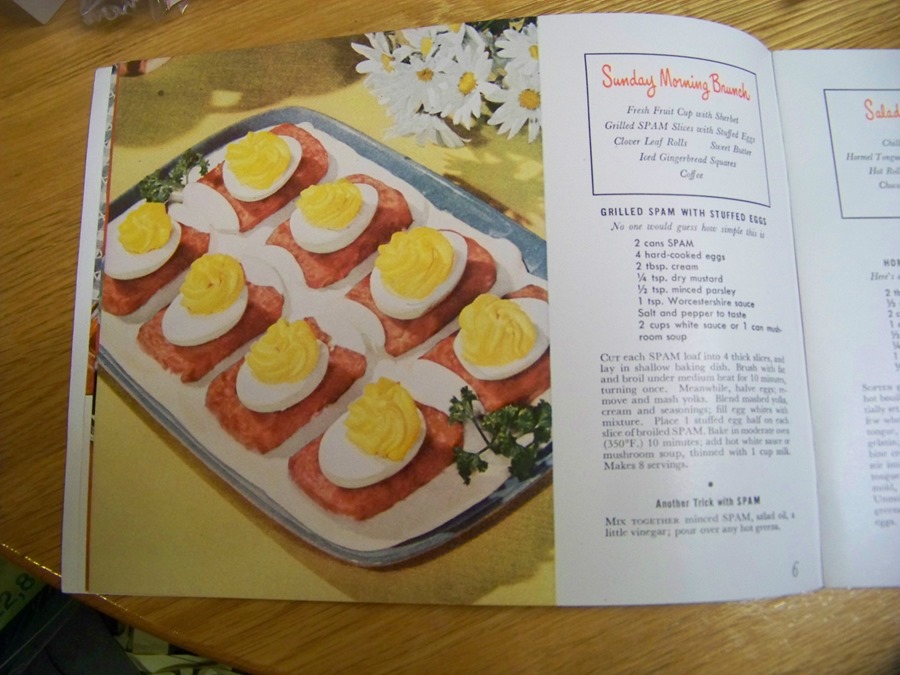However, finding a Spam recipe was more difficult than I first anticipated. For health reasons, we are a no gluten/grain, no processed sugar household. And the recipe had to not make me gag when I thought about actually eating it. (Ok, I am wimping out here, but when I say I am fascinated and horrified by 1950s recipes. Spam falls solidly on the side of "horrified")
This immediately ruled out recipes like Peachy Spam Dinner Loaf
midcenturymenu.com actually made this and my hat is off to them.They are a braver pair than I!
However, I found pictures from a 1948 Spam cookbook on midcenturymenu.com that included a recipe of something that met my criteria for the challenge: Grilled Spam slices and stuffed eggs.
No processed, no gluten -the only deal breaker was the white sauce (contains flour) or cream of mushroom (I'm allergic to mushrooms) soup they call for as a topping. But substituting hollandaise sauce didn't feel like a deviation from the spirit of the recipe.
Shopping for Spam was an eye opening experience. Who knew there were so many kinds!
Jalapeno Spam, classic Spam, Spam lite, Low Sodium Spam...the mind boggles!
The amount of sodium in classic Spam was absolutely insane, especially since there were 6 servings in a can, so I went with low sodium. Still more sodium than we eat in an entire day, but sacrifices must be made for the sake of historical research, eh?
Nutritional data for classic Spam
I must confess I cheated a bit on the stuffed eggs. I bought pre-peeled, hard boiled eggs. There are few things in cooking I dislike more than peeling hard boiled eggs (although I love eating them). But, it was a "convenience food" and the 1950s were all about convenience foods, so it still seemed in keeping with the challenge.
The stuffed eggs part of the recipe was essentially a sort of bland deviled egg recipe and that went together easily enough. Now that I know how easy deviled eggs are with pre-peeled eggs, I suspect there will be a lot more deviled eggs around our house.
I used Alton Brown's Hollandaise sauce which worked well. (I used coconut sugar, since it was all we had in the house and it didn't seem to make a difference in the finished product)
Then it was time to actually open the can of Spam. It certainly didn't win any points for appealing straight out of the can. in fact, it was rather disgusting looking.
Despite the recipe title being "Grilled Spam slices" the recipe said to broil the spam. I went with doing it in the skillet in hopes it would crisp up a bit. Which it did nicely after about 7 minutes on each side. I also sliced it into sixths not fourths, which might have helped.
About two minutes after I put the Spam on, Jay said: "what is that smell? Is something burning?" Spam cooking does not have a terribly enticing smell. It's a little like burning rubber. Definitely not tantalizing to the taste buds.
However, the end product was more edible than I expected , if ridiculous in the amount of fat and sodium.
The Challenge: #3 Today in History
The Recipe: Grilled Spam Slices with Stuffed Eggs
The Date/Region: 1948
Total time: About an hour of solid work
Total cost: $2.69 for a can of Spam and $5 or so for the pre-hardboiled eggs
How successful was it? It's not something I would make again, but it didn't have to force myself to eat it.













